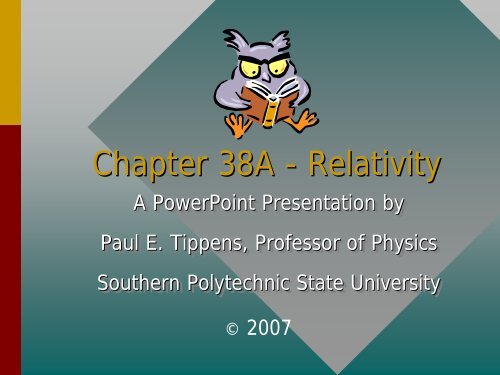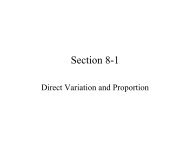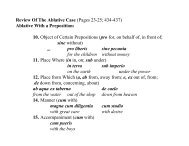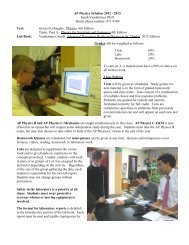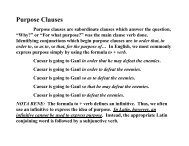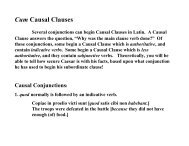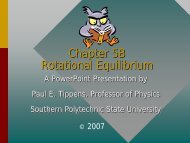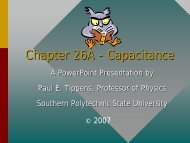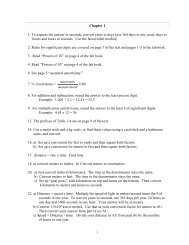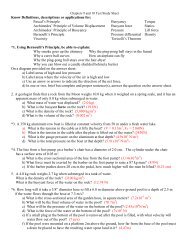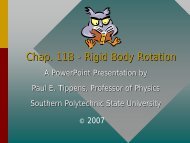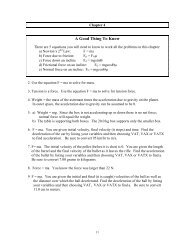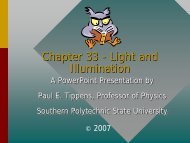Chapter 38A -- Relativity
Chapter 38A -- Relativity
Chapter 38A -- Relativity
You also want an ePaper? Increase the reach of your titles
YUMPU automatically turns print PDFs into web optimized ePapers that Google loves.
<strong>Chapter</strong> <strong>38A</strong> - <strong>Relativity</strong><br />
A PowerPoint Presentation by<br />
Paul E. Tippens, Professor of Physics<br />
Southern Polytechnic State University<br />
© 2007
Objectives: After completing this<br />
module, you should be able to:<br />
• State and discuss Einstein’s s two<br />
postulates regarding special relativity.<br />
• Demonstrate your understanding of time<br />
dilation and apply it to physical<br />
problems.<br />
• Demonstrate and apply equations for<br />
relativistic length, momentum, mass,<br />
and energy.
Special <strong>Relativity</strong><br />
Einstein’s Special Theory of <strong>Relativity</strong>, , published<br />
in 1905, was based on two postulates:<br />
I. I. The laws of of physics are the same for all<br />
frames of of reference moving at at a constant<br />
velocity with respect to to each other.<br />
II. The free space velocity of of light c is<br />
is<br />
constant for all observers, independent of<br />
of<br />
their state of of motion. ( (c (c = 3 x 10 8 m/s)
Rest and Motion<br />
What do we mean when we say that an object<br />
is at rest . . . or in motion? ? Is anything at rest?<br />
We sometimes say that<br />
man, computer, phone,<br />
and desk are at rest.<br />
We forget that the Earth<br />
is also in motion.<br />
What we really mean is that all are moving with<br />
the same velocity. . We can only detect motion in<br />
reference to something else.
No Preferred Frame of Reference<br />
What is the velocity of<br />
the bicyclist?<br />
We cannot say without<br />
a frame of reference.<br />
West<br />
Earth<br />
25 m/s<br />
East<br />
10 m/s<br />
Assume bike moves at 25 m/s,W relative to Earth<br />
and that platform moves 10 m/s, E relative to Earth.<br />
What is the velocity of the bike relative to platform?<br />
Assume that the platform is the reference, then<br />
look at relative motion of Earth and bike.
Reference for Motion (Cont.)<br />
To find the velocity of the bike relative to<br />
platform, , we must imagine that we are sitting<br />
on the platform at rest (0(<br />
0 m/s) ) relative to it.<br />
We would see the Earth moving westward at<br />
at<br />
10 m/s and the bike moving west at at 35 m/s.<br />
Earth as Reference<br />
West<br />
25 m/s<br />
East<br />
10 m/s<br />
Platform as Reference<br />
West<br />
35 m/s<br />
East<br />
0 m/s<br />
Earth<br />
0 m/s<br />
10 m/s
Platform as Reference<br />
West<br />
Frame of<br />
Reference<br />
Consider the velocities<br />
for three different<br />
frames of reference.<br />
35 m/s<br />
East<br />
0 m/s<br />
Earth as Reference<br />
West<br />
Earth<br />
25 m/s<br />
0<br />
East<br />
10 m/s<br />
Bicycle as Reference<br />
West<br />
0 m/s<br />
East<br />
35 m/s<br />
10 m/s<br />
25 m/s
Constant Velocity of Light<br />
Platform v = 30 m/s to right relative to ground.<br />
c<br />
c c<br />
c<br />
10 m/s<br />
10 m/s<br />
20 m/s<br />
40 m/s<br />
Velocities observed<br />
inside car<br />
Velocities observed<br />
from outside car<br />
The light from two flashlights and the two<br />
balls travel in opposite directions. . The<br />
observed velocities of the ball differ, but the<br />
speed of light is independent of direction.
Velocity of Light (Cont.)<br />
Platform moves 30 m/s to right relative to boy.<br />
c<br />
c<br />
30<br />
Each observer sees<br />
m/s c = 3 x 10 8 m/s<br />
10 m/s<br />
10 m/s<br />
m/s<br />
Outside observer sees very<br />
different velocities for balls.<br />
The velocity of light is unaffected by relative<br />
motion and is exactly equal to:<br />
c = 2.99792458 x 10 8 m/s
Simultaneous Events<br />
The judgment of simultaneous events is also a<br />
matter of relativity. Consider observer O T sitting on<br />
top of moving train while observer O E is on ground.<br />
A<br />
A T<br />
A E<br />
Not simultaneous<br />
O T<br />
O E<br />
Simultaneous<br />
B E<br />
B<br />
B T<br />
At t = 0, lightning<br />
strikes train and<br />
ground at A and B.<br />
Observer O E sees<br />
lightning events A E &<br />
B E as simultaneous.<br />
Observer O T says event B T occurs before event A T<br />
due to motion of train. Each observer is correct!
Time Measurements<br />
Since our measurement<br />
of time involves judg-<br />
ments about simul-<br />
taneous events, we can<br />
see that time may also<br />
be affected by relative<br />
motion of observers.<br />
In fact, Einstein's theory shows that observers<br />
in in relative motion will judge times differently -<br />
furthermore, each is is correct.
Relative Time<br />
Consider cart moving with velocity v under a<br />
mirrored ceiling. A light pulse travels to ceiling and<br />
back in time t o for rider and in time t for watcher.<br />
d<br />
2d<br />
c t<br />
t o<br />
Light path<br />
for rider<br />
0<br />
2R<br />
c t R R<br />
d<br />
x<br />
t<br />
Light path ct<br />
vt<br />
R<br />
; x<br />
for watcher 2 2
Relative Time (Cont.)<br />
d<br />
c<br />
2d<br />
t<br />
0<br />
t<br />
c<br />
2t<br />
v<br />
2t<br />
d<br />
R<br />
t o<br />
Light path<br />
for rider<br />
2 2<br />
c v <br />
<br />
2t<br />
2t<br />
<br />
<br />
d<br />
2<br />
Substitution of:<br />
d<br />
<br />
ct<br />
2<br />
0<br />
t<br />
2 2<br />
c v 0<br />
t<br />
ct0<br />
<br />
22<br />
<br />
2t<br />
21<br />
<br />
tv c 2 <br />
2
Time Dilation Equation<br />
Einstein’s Time<br />
dilation Equation:<br />
t<br />
<br />
t<br />
1<br />
v<br />
0<br />
c<br />
2 2<br />
t = Relative time (Time measured in frame<br />
moving relative to actual event).<br />
t o = Proper time (Time measured in the<br />
same frame as the event itself).<br />
v = Relative velocity of two frames.<br />
c = Free space velocity of light ( (c = 3 x 10 8 m/s).
Proper Time<br />
The key to applying the time dilation equation is<br />
to distinguish clearly between proper time t o<br />
and relative time t. . Look at our example:<br />
Event<br />
d<br />
Frame<br />
t o<br />
Proper<br />
Time<br />
Relative<br />
Frame<br />
t<br />
Relative<br />
Time<br />
t > t o
Example 1: Ship A passes ship B with a<br />
relative velocity of 0.8c (eighty percent of the<br />
velocity of light). A woman aboard Ship B<br />
takes 4 s to walk the length of her ship. What<br />
time is recorded by the man in Ship A?<br />
Proper time t o = 4 s<br />
Find relative time t<br />
t<br />
<br />
t<br />
1<br />
v<br />
0<br />
c<br />
2 2<br />
A<br />
B<br />
v = 0.8c<br />
4.00 s 4.00 s<br />
t<br />
<br />
2 2<br />
t = 6.67 s<br />
1- (0.8 c) / c 1- 0.64
The Twin Paradox<br />
Two twins are<br />
on Earth. One<br />
leaves and<br />
travels for 10<br />
years at 0.9c.<br />
When traveler<br />
returns, he is 23<br />
years older due<br />
to time dilation!<br />
t<br />
<br />
t<br />
1<br />
v<br />
0<br />
c<br />
2 2<br />
Traveling twin<br />
ages more!<br />
Paradox: Since motion is<br />
relative, isn’t t it just as true that<br />
the man who stayed on earth<br />
should be 23 years older?
The Twin Paradox Explained<br />
The traveling twin’s<br />
motion was not<br />
uniform. Acceleration<br />
and forces were<br />
needed to go to and<br />
return from space.<br />
Traveling twin<br />
ages more!<br />
The traveler<br />
ages more and<br />
not the one who<br />
stayed home.<br />
This is NOT science fiction.<br />
Atomic clocks placed aboard<br />
aircraft sent around Earth and<br />
back have verified the time<br />
dilation.
Length Contraction<br />
Since time is affected by<br />
relative motion, length<br />
will also be different:<br />
L<br />
L v c<br />
0<br />
1<br />
2 2<br />
L o is proper length<br />
L is relative length<br />
L o<br />
L<br />
0.9c<br />
Moving objects are foreshortened due to to relativity.
Example 2: A meter stick moves at 0.9c<br />
relative to an observer. What is the relative<br />
length as seen by the observer?<br />
L<br />
L v c<br />
0<br />
1<br />
2 2<br />
L(1 m) 1 (0.9 c) / c<br />
2 2<br />
L (1 m) 10.81 0.436 m<br />
L o<br />
L = ?<br />
1 m<br />
0.9c<br />
Length recorded by observer:<br />
L = 43.6 cm<br />
If the ground observer held a meter stick, the<br />
same contraction would be seen from the ship.
Foreshortening of Objects<br />
Note that it is the length in the direction of<br />
relative motion that contracts and not the<br />
dimensions perpendicular to the motion.<br />
Assume each holds a<br />
meter stick, in example.<br />
If meter stick is 2 cm<br />
wide, each will say the<br />
other is only 0.87 cm<br />
wide, but they will<br />
agree on the length.<br />
W o<br />
1 m=1 m<br />
0.9c<br />
W
Relativistic Momentum<br />
The basic conservation laws for momentum and<br />
energy can not be violated due to relativity.<br />
Newton’s s equation for momentum (mv)) must be<br />
changed as follows to account for relativity:<br />
Relativistic<br />
momentum:<br />
p<br />
<br />
mv<br />
0<br />
1<br />
v<br />
c<br />
2 2<br />
m o is the proper mass, , often called the rest<br />
mass. . Note that for large values of v, , this<br />
equation reduces to Newton’s s equation.
Relativistic Mass<br />
If momentum is to be conserved, the relativistic mass<br />
m must be consistent with the following equation:<br />
Relativistic<br />
mass:<br />
m<br />
<br />
m<br />
0<br />
1<br />
v<br />
c<br />
2 2<br />
Note that as an object is accelerated by a<br />
resultant force, its mass increases, which<br />
requires even more force. This means that:<br />
The speed of of light is is an ultimate speed!
Example 3: The rest mass of an electron is<br />
9.1 x 10 -31<br />
kg. . What is the relativistic mass if<br />
its velocity is 0.8c ?<br />
m<br />
<br />
m<br />
0<br />
1<br />
v<br />
c<br />
2 2<br />
- 0.8c<br />
m o = 9.1 x 10 -31<br />
kg<br />
m<br />
<br />
-31 -31<br />
9.1 x 10 kg 9.1 x 10 kg<br />
1 (0.6 c)<br />
c<br />
2 2<br />
<br />
0.36<br />
m = 15.2 x 10 -31 kg<br />
The mass has<br />
increased by 67% !
Mass and Energy<br />
Prior to the theory of relativity, scientists<br />
considered mass and energy as separate<br />
quantities, each of which must be conserved.<br />
Now mass and energy must<br />
be considered as the same<br />
quantity. We may express<br />
the mass of a baseball in<br />
joules or its energy in<br />
kilograms! ! The motion adds<br />
to the mass-energy.
Total Relativistic Energy<br />
The general formula for the relativistic total<br />
energy involves the rest mass m o and the<br />
relativistic momentum p = mv.<br />
E ( m c ) p c<br />
Total Energy, E<br />
2 2 2<br />
0<br />
For a particle with zero<br />
momentum p = 0:<br />
For an EM wave, m 0 = 0,<br />
and E simplifies to:<br />
E = m o c 2<br />
E = pc
Mass and Energy (Cont.)<br />
The conversion factor between<br />
mass m and energy E is:<br />
E o = m o c 2<br />
The zero subscript refers to proper or rest values.<br />
A 1-kg 1<br />
block on a table has an energy<br />
E o and mass m o relative to table:<br />
1 kg<br />
E o = (1 kg)(3 x 10 8 m/s) 2<br />
E o = 9 x 10 16 J<br />
If the 1-kg 1<br />
block is in relative motion, its kinetic<br />
energy adds to the total energy.
Total Energy<br />
According to Einstein's theory, the total energy<br />
E of a particle of is given by:<br />
Total Energy: E = mc 2<br />
(m o c 2 + K)<br />
Total energy includes rest energy and energy<br />
of motion. If we are interested in just the<br />
energy of motion, we must subtract m o c 2 .<br />
Kinetic Energy: K = mc 2 – m o c 2<br />
Kinetic Energy: K = (m – m o )c 2
Example 4: What is the kinetic energy of a<br />
proton (m o = 1.67 x 10 -27<br />
kg) traveling at 0.8c?<br />
m<br />
<br />
m<br />
0<br />
1<br />
v<br />
c<br />
2 2<br />
+ 0.7c<br />
m o = 1.67 x 10 -27<br />
kg<br />
m<br />
<br />
-27 -27<br />
1.67 x 10 kg 1.67 x 10 kg<br />
1 (0.7 c)<br />
c<br />
2 2<br />
<br />
0.51<br />
; m = 2.34 x 10 -27<br />
kg<br />
K = (m – m o )c 2 = (2.34 x 10 -27<br />
kg – 1.67 x 10 -17<br />
kg)c 2<br />
Relativistic Kinetic Energy K = 6.02 x 10 -11 -11 J
Summary<br />
Einstein’s Special Theory of <strong>Relativity</strong>, , published<br />
in 1905, was based on two postulates:<br />
I. I. The laws of of physics are the same for all<br />
frames of of reference moving at at a constant<br />
velocity with respect to to each other.<br />
II. The free space velocity of of light c is<br />
is<br />
constant for all observers, independent of<br />
of<br />
their state of of motion. ( (c (c = 3 x 10 8 m/s)
Summary (Cont.)<br />
Relativistic<br />
time:<br />
t<br />
<br />
t<br />
1<br />
v<br />
0<br />
c<br />
2 2<br />
Relativistic<br />
length:<br />
L<br />
L v c<br />
0<br />
1<br />
2 2<br />
Relativistic<br />
mass:<br />
m<br />
<br />
m<br />
0<br />
1<br />
v<br />
c<br />
2 2
Summary(Cont.)<br />
Relativistic<br />
momentum:<br />
p<br />
<br />
mv<br />
0<br />
1<br />
v<br />
c<br />
2 2<br />
Total energy: E = mc 2<br />
Kinetic energy: K = (m – m o )c 2
CONCLUSION: <strong>Chapter</strong> <strong>38A</strong><br />
<strong>Relativity</strong>


